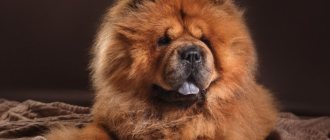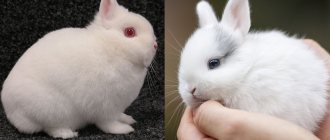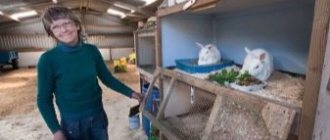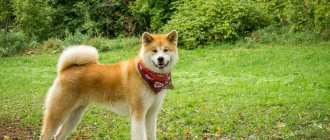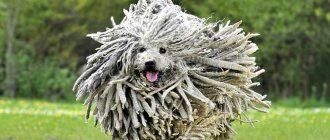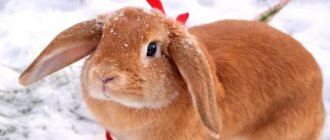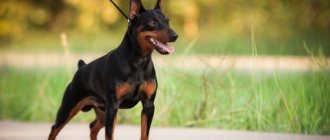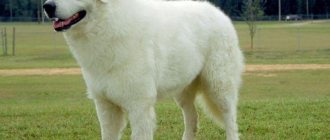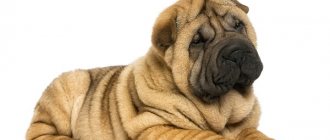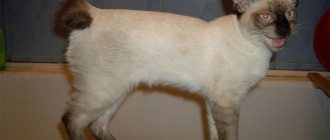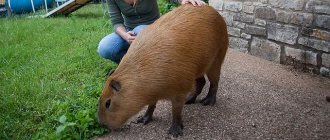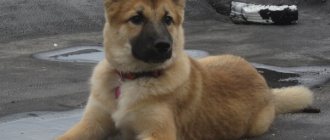- home
- Rabbits
- Breeds
10/07/2018 Breeds of decorative rabbits amaze with their diversity and quantity. When choosing a furry friend, potential owners' eyes widen. Often, when choosing an animal, rabbit breeders are guided not only by the appearance of the rodent. To choose the one that is suitable based on the external characteristics, characteristics of care and maintenance of the pet, you should carefully study all the possible options.
Selection of popular breeds
There are many breeds of rabbits suitable for home keeping. For ease of grooming, it is better to give preference to varieties with short hair and small body size.
Most often, professionals advise choosing the following types.
Dutch
This breed was developed in the Netherlands. They are distinguished by their two-tone color. Eye color determines the coloring of certain areas of the head and back of the body. The front area and toes of the feet are usually white. The contrast boundary is clear.
The first official descriptions of this species appeared in the 19th century, but it is believed that the breed was developed much earlier - in the 15th century.
These cute and affectionate pets get along well with people and are not aggressive towards children. The size of the rabbit is small, maximum weight is about 2 kg. There are many colors - more than 20.
Dutch Fold
They differ from the previous breed in that the ears are not too long, hang down, but do not touch the floor. May be solid color. They are non-aggressive and get along well in an apartment. One of the smallest in size among ornamental breeds.
Dwarf Fold Rams
They are distinguished by hanging ears, an average length of the coat with an undercoat, and quite large sizes - up to 3 kg. The name of the breed is due to the steep, convex forehead of the individuals. These pets are calm, slow, not cowardly, easy to care for and do not show any aggression.
Also read the article about Ram rabbits.
Colored rabbits (dwarf shorthair)
A very small breed, the maximum weight of adults rarely reaches 1.5 kg. The ears are short, erect, and often have a different color from the main color. There are more than 60 shades of color in total.
The most popular variety is the white Oto, with a single black mark on a snowy background.
Curious and active pets are capable of showing some aggression only during the rutting period.
Pygmy foxes
The small breed (up to 1.2 kg) is covered with fairly long hair (from 3 to 7 mm), only it is shorter on the head. Three colors are common - chinchilla, brown and agouti, but other color variations are also found.
They need high-quality care; individuals can vary greatly in character; there are both calm and restless types of temperament.
Angora
Most varieties of this breed have fur so thick and long that the eyes and nose are not visible. Preference should be given to varieties with smooth, short and shiny hair (up to 5 mm). These are calm pets, well compatible with humans, but the peculiarity of the skin requires careful care.
Read more here.
Dwarf rex
There are a lot of representatives of decorative rabbits with wavy fur. The fur of these pets requires special care.
A lot has been written about Rex rabbits here.
Lion head
This variety is distinguished by the fact that the hair on the head is longer than on the rest of the body. There are many colors, weight and body size are small.
The character of these pets is calm and peaceful. They are able to play with children and do not show aggression towards them.
Also read about Lionhead Rabbit.
Hermelinas
These breeds are very popular in Europe, but are rare in Russia. The weight of individuals rarely reaches 1.2 kg. The color is only snow-white without yellowness. The ears are short and erect. Fur length no more than 2 mm. The short snub nose allows us to draw an analogy with the cat Persian.
They do not tolerate high temperatures well. They are unpretentious in care, but have a rather complex temperament.
More about Hermelina.
Japanese dwarfs
Small pets of various colors are distinguished by long, downy fur. They are very beautiful, but require special care.
Pygmy hare
One of the most common decorative breeds. Medium-sized pets are born completely white; with age, chaotically scattered spots of different colors appear on the body.
Angora lions
It is distinguished by the longest fur among decorative breeds, evenly covering the entire body, even the ears. The color is light red. If the hair grows significantly, it needs a haircut.
These are calm and leisurely pets, almost never showing signs of aggression (with the exception of the rut).
Dwarf butterflies
One of the most popular decorative types. Small rabbits rarely reach 1.5 kg. The shiny short coat has a peculiar pattern - ears, the area around the nose, a wide eye rim, a line in the middle of the back and a scattering of small spots on the sides, usually black or dark in color, and the main background is light or white. The color is symmetrical, and markings on the belly, legs or chest are considered defects. They get along well with people.
Squirrels
The young breed is similar in appearance to these animals and most often the same color. Calm pets are usually medium in size. There are few in Russia.
When choosing a rabbit for home keeping, it is better to consult with specialists, as some breeds are quite aggressive, especially towards children.
Photo gallery of decorative rabbits:
Also read about different breeds of rabbits.
What's so great about the Dwarf Ram?
The hanging ears of the decorative rabbit of the Dwarf Ram breed immediately attract the attention of animal lovers. Such pets become the soul of family comfort and the center of attention at any children's party. True, the ears do not immediately become floppy. Initially, individuals are born with erect ears, and only by 3 weeks do they begin to gradually droop.
Rabbits of the Dwarf Ram breed
The wool of Dwarf Rams is plush and of medium length. Dense and soft, the color can be different, there are a lot of color varieties. The body is squat, the weight of such a rabbit can reach up to 2 kg with normal feeding. A feature of the breed, in addition to drooping ears, is their length, reaching 25 cm! This is a rare indicator for dwarf type breeds.
The last thing worth mentioning is character. He is easy-going, calm, simple, friendly to everyone. Such a pet will get along without problems not only with people, but also with other animals and even birds.
Content Basics
To properly maintain these decorative pets, you need to purchase various items and accessories, as well as learn how to use them correctly.
It is unacceptable to simply bring home a miniature pet and let it wander around the apartment on its own. In this case, both the animal and the household will have problems.
Rabbit house
For a small decorative rabbit, you need to purchase a cage measuring no less than 60 by 80 cm. Install it in the apartment so that direct sunlight does not fall on it and there are no drafts. The corner should not be cold or steam heated. The pet needs comfortable accommodation.
Also read about how to make your own rabbit cage.
A drinking bowl and feeding trough are installed in the house; they should always be clean.
Cleaning for rabbits is necessary regularly to prevent the appearance of an unpleasant odor in the apartment. Periodically carry out a general cleaning of the cage.
It is better not to use chemical disinfectants, so as not to poison the baby, but to use warm water and vinegar.
Thermal mode
Overheating and hypothermia of this pet are unacceptable.
The optimal temperature for living in an apartment or house is +18…+20°C.
The room should be ventilated daily to prevent high humidity, stagnant air and musty smell.
In the hot season, rabbits are prone to overheating; you can reduce it and help your pets by wrapping their ears with a cloth moistened with cool water. Large vessels responsible for thermoregulation of the entire body pass through here.
Hygiene
In a cage for a decorative rabbit, a tray with natural filling is usually installed - soft shavings, sawdust, wood chip pellets. It should be changed as it gets dirty, preferably daily. This pet is highly clean and will not use anything dirty.
If there is no toilet, you will have to frequently change the hay and bedding.
Mr. Tail recommends: walking
A decorative rabbit cannot be kept in a cage all the time. It is advisable to let him out every day under strict human supervision to walk around the apartment or one room for at least 30 minutes. At this time, you need to make sure that he does not chew furniture or wires, and remove all dangerous objects and chemicals from the access area. The cage door should not be closed so that the rabbit can return to the house at any time.
In the summer, at the dacha, you can make a small enclosure on the grass, providing it with a room in the shade where the pet can hide from direct sunlight.
Angora dwarf rabbit
The first type of Angora rabbit has 20 centimeters of thin Angora fur. Due to its decorative appearance, it is not immediately possible to determine what kind of animal it is.
The second type of Angora rabbit is smooth-haired; these rabbits have a fur length that barely reaches 5 centimeters; naturally, their fur coat requires less care.
In both species of dwarf angora, the weight of an adult individual ranges from 1 to 1.6 kilograms. Their long hair completely hides their miniature body. The coloring of rabbits of this breed is predominantly white; gray individuals are rare, but active work is now being carried out to breed blue, red, gray and black Angoras. It is very rare to have blue eyes in rabbits of this breed. One cannot fail to note the tufts of fur, which give this animal a very funny look.
Solving problems with sexual behavior
As a rule, all decorative breeds have a calm character and get along well with people. Some manifestations of aggression are possible during the rutting period. Therefore, if breeding is not planned, it is better to neuter your pets at a young age. As a rule, such individuals live much longer and do not have health problems.
In addition, adult unsterilized males will definitely mark.
Also read the article on how to determine the sex of a rabbit.
Why are decorative individuals needed?
Decorative dwarf rabbits are bred not for meat or fur coats, but as pets. A miniature, furry animal often becomes the best friend not only for a child, but also for adults. The external characteristics of the breeds are varied, so everyone can choose a rodent to suit their taste.
Each animal differs not only in external characteristics, but also in character. Decorative rabbits are calm, peaceful creatures. Conflicts rarely arise between them; they get along well in the same territory. But there are breeds that have a more wayward character. We need to find an approach to them.
It should be remembered that the character and disposition of a pet is often shaped by its owner. A reverent, affectionate, friendly attitude will be the key to raising a pet with the same behavior.
Rules for caring for decorative rabbits
Each breed of decorative rabbits has its own characteristics, but you should know the general rules for caring for these pets:
- You should not bathe rabbits often; they are usually able to take care of their own fur coat. Every bath is stressful for pets, and in addition, the natural protective lubricant is washed away. After walking in the fresh air, it is enough for kids to wash or dry their paws.
- Decorative rabbits must be combed regularly, otherwise they will swallow a lot of hair while licking, which will lead to the formation of hairballs and problems with the gastrointestinal tract. To prevent them, you should feed them a special paste once every two weeks, and daily during the period when the fur is shedding.
- Breeds with long and abundant fur require special care. Their hair needs not only daily combing, but also periodic trimming, especially in the hot season.
- To pick up a rabbit, do not lift it by the ears. It is better to support it between the front paws by the chest or hold it firmly by the scruff of the neck.
- Domestic rabbits need to have their nails trimmed from time to time to avoid scratches on the hands of household members. They are shortened carefully so as not to damage closely adjacent blood vessels and by no more than 1-2 mm.
- You definitely need to choose a name for your pet; many kids get used to the nickname and react to it.
- In order for a baby rabbit to grow into a truly tame pet, it must be raised in a timely and affectionate manner.
What are the characteristics of Hermelin rabbits?
We recommend reading our other articles
- How long do rabbits live?
- When to dig up gladioli
- Cucumber variety Zozulya
- Phoenix chicken breed
Rabbits of the Hermelin breed are among the most beautiful. They have a rounded head, red or blue slightly bulging eyes, and small erect ears. The body is small but strong, the legs and neck are very short.
Rabbit breed Hermelin
The coat is medium length and only white! Weight can reach up to 1 kg. As for character, Hermelins have a friendly and calm disposition; “fighting” individuals are very rare.
Feeding
The diet of decorative rabbits should be correct and varied.
Ideally, it must include:
- Fresh grass and pre-harvested hay. These can be leaves of dandelion, plantain, alfalfa, clover, and cereals. This type of food is given not freshly cut, but slightly dried. The hay should be in the feeder at all times; care must be taken to ensure that there is no mold on it.
- Branch food - young fresh branches of trees and shrubs.
- Ready-made industrial feed. One or two spoons are enough for a day; young individuals are given this food three times a day.
- Cultivated greens from the garden - carrot tops, parsley, lettuce.
- Fruits and vegetables - apples, pears, bananas, cucumbers, zucchini, carrots, turnips. They need to be cut into small pieces.
- Berries - currants, raspberries, strawberries, grapes, pieces of watermelon.
- Dried fruits - given in small quantities mainly in winter and spring.
- Sprouted grains, such as wheat grass or oats, and sunflower seeds in small quantities.
Also read the article about what to feed rabbits at home.
Rabbits must always have food in the feeder, otherwise stagnation and fermentation begin in the pet’s intestines.
Prohibited foods include everything spicy, salty, smoked, canned, sweet, baked goods, and dairy products.
You should not give fruit seeds and cabbage leaves, beets and citrus fruits; not all branches are suitable - for example, cherries are prohibited.
There should also be a special stone in the cage; you can buy it at a pet store. Rabbits not only grind their teeth on it, but also receive many useful substances - calcium, phosphorus, magnesium, and other micro- and macroelements.
There should always be clean water in the drinking bowl.
Dwarf hotot (Blanc de Hotot)
A very rare, and therefore more desirable breed for lovers of rare and beautiful animal breeds. This little animal was bred in Germany, although the French were the first to try to breed this breed.
The average weight of an adult individual barely reaches the 1.3 kilogram mark . A small but very compact body, very short ears, short and strong legs and an amazingly beautiful black eye rim are the characteristic features of this breed. Unlike other dwarf rabbit breeds, they are very playful, sociable, obedient and gentle.
Their fur is dense, shiny and fine. A true dwarf hotot has an exclusively white body color, but with breeding it can also produce another type of color. Today, the breed of colored dwarf hotots has already been officially recognized.
Practical advice
Some more tips from experienced rabbit breeders will not be superfluous:
- You should always speak kindly to your pet, pet it, play with it, and pick it up more often.
- During the day, rabbits prefer to sleep or hide from others, so it is better to actively tinker with them in the evening so that the pets get tired.
- Decorative rabbits can make noise at night, so you should try to accustom them to sleep at night, and place the cage away from the bedrooms of household members.
- A miniature pet needs toys, you can buy them at a pet store. These can be special balls, cardboard boxes with holes. Otherwise, the baby will find them himself, for example, he will peel off the wallpaper.
- Natural instincts force a rabbit to chew something all the time, therefore, in addition to a special grindstone, you can also put pieces of wood and natural fabric in the cage.
- You should not combine keeping a rabbit with other pets in the house. Loud noises that dogs or cats make will frighten them. And large animals can injure this baby.
- You shouldn't be afraid of pet odors. With proper care and timely castration, they will not exist.
- It is important to comply with the schedule and regime of mandatory vaccination. In case of outbreaks of infections, the list of vaccinations should be expanded.
We want a rabbit the size of your palm
It all depends on the size of your palm)) But seriously, there are no adult dwarf rabbits the size of a hamster; babies can be this size, for example minors. At 1.5 months they weigh about 300-400 grams, the size of half a palm.
Adult animals weigh about 1 kg and measure about 20-25 cm, which is just the size of the palm of an adult man or slightly longer than the length of a ballpoint pen. But we must take into account that such a small animal requires more careful care and maintenance, as it is easy for them to cause various injuries through negligence.
Diseases and prevention
The usual life expectancy of decorative breed rabbits is about 7-8 years.
Proper care, regular and nutritious feeding, and attentive attention to your pet will help prolong its life and make its stay in the house joyful.
Any inappropriate, atypical behavior for a rabbit, loss of appetite or complete refusal to eat cannot be ignored; you should immediately contact a veterinarian if you suspect a disease.
Most often, decorative rabbits suffer from the following pathologies:
- stomatitis;
- conjunctivitis;
- rhinitis;
- acute respiratory infections and pneumonia;
- staphylococcosis;
- pasteurellosis;
- coccidosis;
- myxomatosis;
- gastrointestinal disorders - diarrhea and constipation.
Read more about rabbit diseases on our portal here.
Regular deworming (preferably once every three months), treatment for external parasites and vaccination can improve the standard of living of rabbits.
Mandatory vaccinations for rabbits include the following, which protect pets from diseases:
- rabies;
- salmonellosis;
- myxomatosis;
- viral hemorrhagic fever (VHF).
Usually the first vaccine is administered at the age of 6 weeks, but in the event of an outbreak of a disease in the region, it is also possible to vaccinate one-month-old babies. After 3 months, revaccination is carried out, then it is repeated every six months.
It is not advisable to vaccinate lactating females and pregnant rabbits. After vaccinations, the rabbits are kept in quarantine for two weeks.
Names for rabbits girls and boys
The pet's name should be short and sonorous, then he will quickly learn it.
IMPORTANT: At first, as soon as the rabbit begins to respond to the call, you need to encourage it with a treat.
Many owners choose a nickname based on the obvious distinctive features of the rabbit: color, habits, character traits:
- An albino pet , if it is a boy, can be called Bely, Snezhok, White , if it is a girl - Blonda, Snezhka, Anzhi, Belyan
- For gray rabbits, suitable names are Gray, Smokey, Brass - for boys, Mini, Smoke - for girls
- A restless baby can be called Shustrik, Dashing , if it is a boy, but if it is a girl - Naughty, Shursha, Shusha
Some rabbit owners name their pets after their favorite characters from feature films and cartoons:
- Elsa, Feona, Jasmine, Gloria, Bella, Hera for females
- Nemo, Marty, Funtik, Kuzya , Simka for males.
There are owners who humanize their furry and call boys with male names - Vanka, Max, Zhorik , and girls with female names - Lana, Nora, Shura .
A decorative rabbit will quickly get used to its name and learn to come running when called.
IMPORTANT: Once a pet begins to respond to its name, it must not be changed under any circumstances.
conclusions
Summing up the decorative breeds of rabbits, it is worth once again highlighting important points when choosing a breed:
- In total, there are more than 200 types of decorative rabbits, but when purchasing from the seller, there must be a pedigree for the animal indicating the breed and parents.
- Dwarf breeds weigh a maximum of 2 kg, and the length of the ears does not exceed 6 cm.
- Each variety of eared animals has its own character, and before purchasing a pet, you should carefully study this aspect in order to avoid unpleasant surprises.
- Long-haired species require regular brushing and removal of pellets. In addition to such care, it is also worth regularly vaccinating your rabbit - which and when to do is described here.
- Rabbits cannot tolerate loud sounds or bright lights. This can cause them to lose their appetite and get sick.
Also read about the dwarf breed - the fold-eared Ram.
Where is the best place to buy a decorative rabbit?
You can buy a baby rabbit:
- in the nursery;
- in a pet store;
- at the poultry market;
- through an Internet bulletin board.
Breeders advise using the first two options. By purchasing an animal from a specialized institution, you receive a guarantee that the baby is healthy, vaccinated and meets the breed standard.
As you can see, there are many varieties of decorative rabbits. The main advice is to choose your pet with your heart. Then he will become a friend and a full-fledged member of the family.
